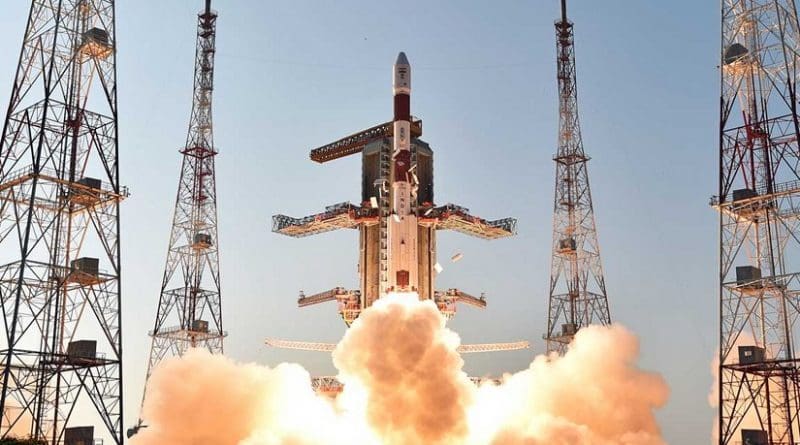An A-SAT Test Ban Can Wait: India Needs To Widen Kinetic A-SAT Capabilities – Analysis
By Observer Research Foundation
By Kartik Bommakanti
In late March 2019, the Modi government took a momentous and courageous decision to conduct a kinetic Anti-Satellite Test (A-SAT) dubbed “Mission Shakti”. The A-SAT was obviously a response to the growing asymmetry in counter-space capabilities between India and the People’s Republic of China (PRC). Given the destructive effects that Kinetic Energy Weapons (KEWs) produce in the form of orbital debris endangering orbiting spacecraft and space exploration in the long run, there is opposition to kinetic A-SATs.
Due to this, a recent United States-sponsored resolution received wide support with as many as 155 member states supporting the resolution at the United Nations General Assembly (UNGA). This was obviously a non-binding resolution as the UNGA is not the UN’s apex security institution which is performed by the United Nations Security Council (UNSC). Predictably, China and Russia among the most consequential space military powers and also veto-wielding permanent members of the UNSC voted against this US-sponsored resolution.
Although the resolution is non-binding, it might be tempting to view this as an invitation for India to commit to a unilateral moratorium, the implication being that New Delhi too commits to at least a de facto or unilateral ban against Kinetic Energy Weapon (KEW) tests as the US has done, because of the benefits it would bring in preventing or at least mitigating orbital debris. Notably, just as India did, Pakistan abstained from supporting the UNGA resolution. By way of their abstention, the Pakistanis are certainly in no mood to concede the option of conducting an ASAT of their own, let alone the PRC, therefore there is no need for New Delhi to rush headlong into an ASAT ban undermining its capacity to strengthen its KEW capabilities.
Notwithstanding the growing support for debris-generating kinetic ASAT to be curbed by way of a moratorium, New Delhi must resist committing to the latter unilaterally and multilaterally, either tacitly or explicitly. India’s options must be geared toward widening its kinetic capabilities against its adversaries’ orbiting spacecraft. The PRC alone is not the problem for New Delhi, but also, the collusive threat posed by China and Pakistan, which warrants additional tests. That apart, the American-sponsored resolution can be ignored, which the bulk of the worlds’ major space powers has done either by way of opposing it or abstaining from it.
Secondly, the Biden administration’s decision to unilaterally adhere to a moratorium on KEW tests can easily be reversed by a future Republican administration. Indeed, Republicans have already expressed scepticism about the US’ self-imposed A-SAT ban, because the Russians and Chinese would not adhere to unilateral restraint in the conduct of kinetic A-SATs, when it was announced in April 2022. Consequently, they have been vindicated by Moscow and Beijing’s opposition to the UNGA resolution against kinetic A-SATs passed in December 2022.
What should India do? India should conduct a ship-based kinetic A-SAT as well as develop and test an air-launched KEW. As was the case with its March 2019 ground-launched direct ascent KEW test destroying one of its own defunct satellites, India should execute low orbital altitude sea and air-launched A-SATs, which would significantly limit debris fallout.
The March 2019 test was conducted by the Defence Research and Development Organisation (DRDO) at an altitude of 300 kilometers (Kms), which created debris of around 400 pieces, most or 95 percent of which fell back to earth within the first month of the test.
As of today, in all likelihood, almost all the debris cloud generated by the Indian test has decayed posing no real hazard to orbiting spacecraft. As long as India’s KEW tests are well outside or under the most crowded orbits located at 800 km above the earth, New Delhi can proceed. The Indian A-SAT test of March 2019 was nowhere as dangerous in terms of debris fallout as the Chinese and Russian A-SATs of January 2007 and November 2021 respectively.
Alternatively, in order to address concerns about space debris generation, New Delhi could also carry out both the sea-launched and air-launched A-SATs against “empty points” in space involving a kinetic missile travelling through a zone or predetermined point in space obviating and substituting for the destruction of an actual spacecraft.
To achieve this India also needs better sensor technology to precisely track the kinetic projectiles and identify the “empty points” through which they would pass. The missile will also need to be reconfigured and its software modified for kinetic interception. The Dhanush Ship-based Ballistic Missile (ShLBM) is a good candidate and currently deployed on the Indian Navy’ (IN) Off-shore Patrol Vessels (OPVs) of the Sukanya Class. The DRDO and the IN must determine whether the missile can also be adapted for launch from the Visakhapatnam Class guided missile destroyers, which are the most advanced destroyers in the Indian Navy’ (IN) surface fleet. Alternatively, a whole new kinetic interceptor missile may need to be developed for launch from a surface vessel, which should ideally be a guided missile destroyer.
A corollary to the above is that strengthening India’s A-SAT capabilities from sea-based and air-launched platforms creates options for the country in wartime, giving flexibility and creating redundancy. New Delhi aptly abstained from supporting the resolution, but it should not lose sight of the importance of an A-SAT triad. Whatever benefits may be of the UNGA resolution passed last December, India must keep its powder dry and fulfil its counter-space KEW requirements. Although arms control against debris-generating A-SATs is necessary, it is premature. Thus, New Delhi must resist putting the cart before the horse.

